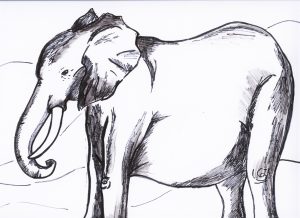
Author: Layal Bou Abdo MSN
Illustration: Angeline Boswell
Elephants are large mammals that have long trunks and big ears. African elephants are the largest land animals in the world. They can get as tall as 13 feet (4 meters) and weigh as much as 14000 pounds (6 tonnes). The natural habitats of elephants are in the wild of some parts of Africa, South Asia and Southeast Asia. So why do they have big ears, tusks and long trunk?
Why do elephants have tusks?
Tusks are massive teeth (incisors) that grow beyond the mouth of the elephant. These ivory teeth are beautiful and essential for animal species’ survival. Tusks grow continuously throughout their lives, extending from deep within their upper jaw. Tusks grow to weigh more than 100 lb (45.35 Kgs).
We also have incisors; they are the teeth at the front of our mouths, which we use for biting food.
Their tusks aid them in carrying out tasks:
- Digging for water or vital minerals in the ground,
- Lifting objects,
- Gathering food,
- Stripping bark from trees to eat to secure fibrous food,
- Defence,
- Helping males compete for females,
- The tusks also protect the trunk.
Just as humans are left or right-handed, elephants, too, are left tusked or right tusked. The dominant tusk gets wear and tear from frequent use.
Both male and female African elephants have tusks, while only male Asian elephants, and only a certain percentage of males today, have tusks.
Why are elephants evolving to be tuskless?
Humans are attracted to the beautiful tusks of elephants. Since Ivory is the most highly prized material in the natural world, its demand has led to the deaths of thousands of elephants across Africa. Moreover, the only way that humans can get hold of their tusks is by killing them. Poachers kill 20,000 elephants per year for their tusks and trade them illegally in the international market. This trade is a wildlife crime. In the past, elephant tusks regularly weighed in at more than 200 lb (91 Kgs). Due to the extent of the poaching of elephants, the big-tusk gene has vanished from the population. Fifty percent of male elephants in the Asian population do not grow tusks at all. Animals with tusks that have the genes to grow tusks are removed from the population by poachers. Animals that do not have tusks survived because they do not appeal to the poachers.
Why do elephants have big ears?
Elephants’ ears are one of the ways to tell the difference between African and Asian elephants.
Asian elephants have smoother skin and smaller ears than African Elephants.
The ears of African elephants can grow six feet (1.82 m) and 4 feet (1.21 m) wide. They resemble the shape of the African continent. On the other hand, the ears of the Asian elephants are round shape.
Elephant ears help them stay cool!
The reason why Asian and African elephants have different ear sizes has to do with their habitats. African elephants live in extreme temperature environments and savannas and need protection from the sun. On the other hand, Asian elephants live in shady forests where they do not see sunlight.
Therefore, they have big ears to help them stay cool. They are huge, which means they produce a lot of body heat. They must have a very efficient way to get rid of their extra body heat. Unlike the human body, the animal body cannot sweat to keep him cool. Luckily, they come with a built-in solution: big, floppy ears.
Thousands of blood vessels make up the animal’s ears. These vessels are thin and close to the skin. They allow the excess body heat to escape the elephant’s body and regulate their body temperature.
Another reason why they have big ears is to use their ears as fans to cool off their bodies. Their ears can cool their body by up to 5° Celcius (that is 9° Fahrenheit)!
Experiment time:
- Hold an ice cube in the palm of your hand. It will start to melt.
Heat flows from an area of high heat to another of low heat.
The ice cube is not making your hand cold. In reality, the heat from your hand is making the ice cube warmer. So, that’s why it melts.
This is exactly what happens in the elephant’s ears when the elephant’s body temperature is greater than the temperature of his surroundings, heat is released from the ears.
Elephants’ ears help them hear long distances and therefore communicate!
The elephants hear up to six miles (10 km) away from their current location. Elephants communicate using a secret language using a low-pitch voice that our ears cannot pick.
Elephants are as noisy as cows on a farm, but since our ears only hear frequencies between 20 Hz and 20 kHz, we cannot hear the ultrasonic sounds that elephants produce while communicating.
Infrasonic sound waves (low frequency) have longer wavelengths and can travel up to 5 KMs (3 miles).
Moreover, the inner ear structure of the elephants is large, making them able to catch infrasonic sound waves. The animals will occasionally raise their ears and stand still to listen to other animals and the sounds of nature. They use their super-hearing to forecast the weather. Elephants can hear a storm nearly from 300 KMs away!
When they try to intimidate someone or animals, they spread their ears wide open to show dominance.

Why do elephants have a long trunk?
The elephants’ trunk is an extension of their nose that fuses with their top lip. They use it for smelling, breathing, trumpeting, drinking, and, to grab things such as food.
Smelling
Scientists found that elephants have over 2,000 genes coding for olfactory receptors. Oh wow! Too many smelling receptors. That means that they have a great sense of smell; 4 times more sensitive than a bloodhound dog. They use their trunk to find food and water that they can smell from 12 miles (around 19 km) away.
Grabbing
African elephants have two finger-like features on the end of their trunk needed to grasp small objects. However, Asian elephants have only one. These fingers are very strong and precise, allowing them to pick up a tiny peanut, break the shell and then eat the uncrushed nut inside.
Trunks can grow up to 2 meters in length, and they can weigh 160 kg (353 pounds). Rings of cartilage support the two nostrils all along the trunk. The trunk does not have bones. Therefore, elephants can move their flexible trunk in whatever direction they need to.
The trunk alone contains about 40,000 muscles compared to humans 650. With all those muscles, the trunk can lift objects of 320 kgs (772 pounds).
Elephants also fill their trunk with water and transfer this water into their mouth. An elephant can hold up to 2 gallons (7.5 litres) of water in one gulp.
Snorkelling
Elephants like to swim to cool off in the water. They use their trunk as snorkels to allow them to breathe.
Show affection
Elephants are emotionally intelligent and they have deep family bonds. They use their trunk to show affection to one another by stroking the head and back of other elephants to caress, show compassion and comfort. The baby elephants also suck on their trunks to comfort themselves. Like when a baby human sucks on his thumb for comfort.
They also use their trunk to trumpet warning one another against wilderness dangers.
Feel their way around
Elephants do not have the best eyesight, so they use their trunks to feel their way through forests. They use their trunks to rip branches and knock down trees to make paths in the forest. Their trunk can reach branches up to 20 feet in height (6 meters)
Elephants have preferred trunk side, just like right-handed/left-handed humans.
Fun Facts
Did you know that elephants:
- Have a larger brain than any other land mammals that can get as big as 13 pounds (6 kgs). That is why they are so clever and have an incredible memory.
- Are herbivores; they only eat plants.
- Ears have a unique pattern of veins; just like fingerprints, no two are alike.
- Can live for up to 60-70 years.
- Spend three-quarters of their time eating as they need around 150 kg of food per day.
- Can communicate through sounds that create vibrations in the ground. They detect sounds vibrations through their bones.
- Some of the longest tusks ever recorded belonged to an old elephant called Ahmed, who lived in Kenya until the ripe old age of 65. His tusks were 3m in length and weighed 67kg each. That is 5kg more than the average weight of an adult human.
- An elephant’s skin is 2.5cm thick and it’s so wrinckly. The folds and wrinkles in their skin can retain up to 10 times more water than flat skin does, which helps to cool them down. They keep their skin clean and protect themselves from sunburn by taking regular dust and mud baths.
We are confident your kid asks you health (human & animal) questions that genuinely leave you stumped! Leave a comment below, and we are happy to answer “why” in future blogs. Reach out to us on Twitter using the #AskTheLittleMedicalSchool
Copyright © 2021 Little Medical School Ottawa



[…] Elephants, kangaroos, and manatees have multiple sets of teeth that grow in the back of their mouth and migrate forward as their front teeth fall out. They are polyphyodonts. […]
Why is it easy for elephants to make friends with humans?
Elephants are intelligent, being the animals with the largest brain and great memory. They are usually gentle with other animals and humans, even in the wild or when in captivity.
They tend not to hurt unless provoked or threatened. Elephants -that grow up in areas with people- are friendly and will not hurt. There are lots of stories about elephant helping humans in the wild. However, there are many other stories of elephants attacking other animals or humans that try to invade their space. Nonetheless, you should always remember that elephants are wild animals that cannot be domesticated.
On the other hand, baby elephants are the friendliest. Just be careful when you are playing with them because they are still experimenting with their strength and might crush you while trying to be playful and show you some affection.
nice post!
So why do they have big ears, tusks and long trunk?
Due to their big size, elephants have grown big ears tusks and trunk to survive and adapt to the environment they live in.
This blog is very good, I like to see the style of writing and the information is very useful
thank you for the article
I just came to this blog for the first time, and I am very interested in the information presented, I will come back another time
Why do elephants have tusks?
Are there any threats to elephants related to their tusks, and how does this impact their population and conservation efforts?
Elephants face a significant threat due to illegal poaching driven by the demand for their ivory tusks. This has led to a substantial decline in elephant populations, disrupting ecosystems and impacting the social structures within herds. Conservation efforts are challenged by insufficient resources, political instability, and the persistent demand for ivory. Global initiatives, including awareness campaigns and international bans on ivory trade, aim to address the issue and protect these majestic animals. However, ongoing and coordinated efforts are essential to combat poaching, safeguard habitats, and ensure the survival of elephants in the wild.
Why do elephants possess tusks, large ears, and lengthy trunks, and how do these features contribute to their survival in their natural habitats?
Elephants possess tusks for various purposes such as digging, lifting, defense, and mating competition. However, due to ivory poaching, many elephants are evolving to be tuskless as a survival strategy.
Their large ears help regulate body temperature by dissipating heat, aiding in cooling their bodies. Additionally, elephants use their ears for long-distance communication, sensing infrasonic sounds, and even forecasting weather.
The lengthy trunk of elephants serves multiple functions including smelling, grabbing objects, drinking, snorkeling, and expressing affection. It also assists in navigation through forests, as elephants have relatively poor eyesight.
Thanks for sharing, Regards URL
URL
[…] Ears: Elephants have large ears that help keep them cool in hot climates by flapping them to create a […]
Nice blog here! Also your web site loads up very fast!
Fakultas Informatika
thank for your information